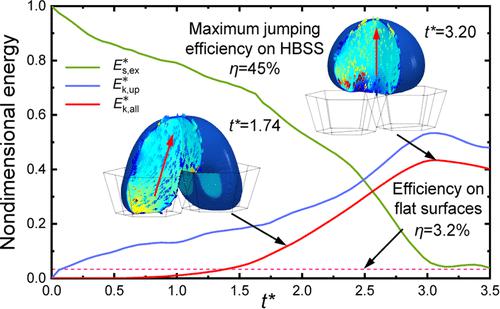Our official English website, www.x-mol.net, welcomes your feedback! (Note: you will need to create a separate account there.)
Coalescence-Induced Droplet Jumping on Honeycomb Bionic Superhydrophobic Surfaces
Langmuir ( IF 3.9 ) Pub Date : 2022-08-02 , DOI: 10.1021/acs.langmuir.2c01335 Yan Gao 1 , Zhaoqing Ke 1 , Wei Yang 1 , Zhiqiang Wang 1 , Ying Zhang 1 , Wei Wu 2
Langmuir ( IF 3.9 ) Pub Date : 2022-08-02 , DOI: 10.1021/acs.langmuir.2c01335 Yan Gao 1 , Zhaoqing Ke 1 , Wei Yang 1 , Zhiqiang Wang 1 , Ying Zhang 1 , Wei Wu 2
Affiliation

|
Condensation-induced jumping of droplets on superhydrophobic surfaces has received extensive attention because of its great potential for applications in areas such as condensation enhancement and self-cleaning. However, the jumping efficiency of droplets on flat superhydrophobic surfaces is very low, and there is no reliable means of achieving efficient droplet jumping on large scales, which greatly limits its application. To this end, we developed a class of honeycomb bionic superhydrophobic surfaces (HBSS) that enable reliable and efficient droplet jumping on a large scale for the first time and performed experimental and simulation studies on droplet condensation and jumping on this kind of surface. Condensation experiments show that condensate droplets on HBSS can be effectively positioned under the influence of gravity and the uniformity of the droplet diameter is ensured, laying the foundation for achieving efficient jumping. The shape and geometric parameters of HBSS have a significant impact on the droplet jumping efficiency, and the maximum dimensionless jumping velocity of droplet jumping was experimentally measured to be 0.747, corresponding to an efficiency of about 45.25%. Combining with the results of simulation calculations, we found that the surface structure of HBSS can promote more of the excess surface energy to net upward kinetic energy along an extremely efficient and simple pathway (direct conversion), thus achieving an energy conversion efficiency of over 45%.
中文翻译:

蜂窝仿生超疏水表面上聚结诱导的液滴跳跃
由于其在冷凝增强和自清洁等领域的巨大应用潜力,超疏水表面上的冷凝诱导液滴跳跃受到了广泛关注。然而,液滴在平坦超疏水表面上的跳跃效率很低,并且没有可靠的手段实现大范围的高效液滴跳跃,极大地限制了其应用。为此,我们开发了一类蜂窝仿生超疏水表面(HBSS),首次实现了大规模可靠和高效的液滴跳跃,并对这种表面上的液滴凝结和跳跃进行了实验和模拟研究。凝结实验表明,HBSS上的凝结水滴在重力影响下可以有效定位,并保证了水滴直径的均匀性,为实现高效跳跃奠定了基础。HBSS的形状和几何参数对液滴跳跃效率有显着影响,实验测得液滴跳跃的最大无量纲跳跃速度为0.747,对应的效率约为45.25%。结合模拟计算的结果,我们发现HBSS的表面结构可以促进更多的多余表面能沿着极其有效和简单的途径(直接转换)净向上动能,从而实现超过45的能量转换效率%。为实现高效跳跃奠定基础。HBSS的形状和几何参数对液滴跳跃效率有显着影响,实验测得液滴跳跃的最大无量纲跳跃速度为0.747,对应的效率约为45.25%。结合模拟计算的结果,我们发现HBSS的表面结构可以促进更多的多余表面能沿着极其有效和简单的途径(直接转换)净向上动能,从而实现超过45的能量转换效率%。为实现高效跳跃奠定基础。HBSS的形状和几何参数对液滴跳跃效率有显着影响,实验测得液滴跳跃的最大无量纲跳跃速度为0.747,对应的效率约为45.25%。结合模拟计算的结果,我们发现HBSS的表面结构可以促进更多的多余表面能沿着极其有效和简单的途径(直接转换)净向上动能,从而实现超过45的能量转换效率%。对应的效率约为 45.25%。结合模拟计算的结果,我们发现HBSS的表面结构可以促进更多的多余表面能沿着极其有效和简单的途径(直接转换)净向上动能,从而实现超过45的能量转换效率%。对应的效率约为 45.25%。结合模拟计算的结果,我们发现HBSS的表面结构可以促进更多的多余表面能沿着极其有效和简单的途径(直接转换)净向上动能,从而实现超过45的能量转换效率%。
更新日期:2022-08-02
中文翻译:

蜂窝仿生超疏水表面上聚结诱导的液滴跳跃
由于其在冷凝增强和自清洁等领域的巨大应用潜力,超疏水表面上的冷凝诱导液滴跳跃受到了广泛关注。然而,液滴在平坦超疏水表面上的跳跃效率很低,并且没有可靠的手段实现大范围的高效液滴跳跃,极大地限制了其应用。为此,我们开发了一类蜂窝仿生超疏水表面(HBSS),首次实现了大规模可靠和高效的液滴跳跃,并对这种表面上的液滴凝结和跳跃进行了实验和模拟研究。凝结实验表明,HBSS上的凝结水滴在重力影响下可以有效定位,并保证了水滴直径的均匀性,为实现高效跳跃奠定了基础。HBSS的形状和几何参数对液滴跳跃效率有显着影响,实验测得液滴跳跃的最大无量纲跳跃速度为0.747,对应的效率约为45.25%。结合模拟计算的结果,我们发现HBSS的表面结构可以促进更多的多余表面能沿着极其有效和简单的途径(直接转换)净向上动能,从而实现超过45的能量转换效率%。为实现高效跳跃奠定基础。HBSS的形状和几何参数对液滴跳跃效率有显着影响,实验测得液滴跳跃的最大无量纲跳跃速度为0.747,对应的效率约为45.25%。结合模拟计算的结果,我们发现HBSS的表面结构可以促进更多的多余表面能沿着极其有效和简单的途径(直接转换)净向上动能,从而实现超过45的能量转换效率%。为实现高效跳跃奠定基础。HBSS的形状和几何参数对液滴跳跃效率有显着影响,实验测得液滴跳跃的最大无量纲跳跃速度为0.747,对应的效率约为45.25%。结合模拟计算的结果,我们发现HBSS的表面结构可以促进更多的多余表面能沿着极其有效和简单的途径(直接转换)净向上动能,从而实现超过45的能量转换效率%。对应的效率约为 45.25%。结合模拟计算的结果,我们发现HBSS的表面结构可以促进更多的多余表面能沿着极其有效和简单的途径(直接转换)净向上动能,从而实现超过45的能量转换效率%。对应的效率约为 45.25%。结合模拟计算的结果,我们发现HBSS的表面结构可以促进更多的多余表面能沿着极其有效和简单的途径(直接转换)净向上动能,从而实现超过45的能量转换效率%。



























 京公网安备 11010802027423号
京公网安备 11010802027423号